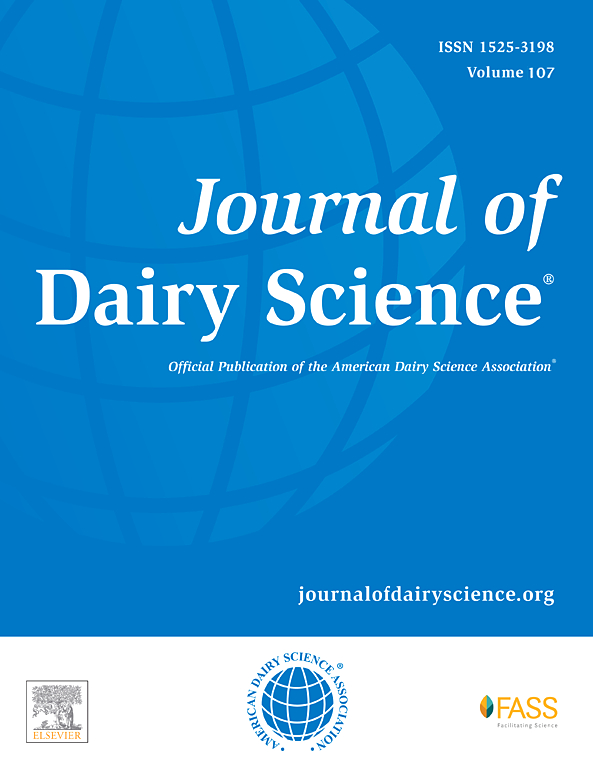Consumer acceptance of protein beverage ingredients: Less is more
IF 3.7
1区 农林科学
Q1 AGRICULTURE, DAIRY & ANIMAL SCIENCE
引用次数: 0
Abstract
An array of ingredients is added to protein beverage formulations. These ingredients may not be desirable to consumers. Our objective was to determine consumer perception of ingredients in protein beverages. An online survey was conducted with protein beverage consumers (n = 405). Maximum difference scaling and projective mapping were applied to determine the relative acceptance of ingredients based on their functional role (protein source, sweetener, stabilizer, thickener). Subsequently, 4 120-min focus groups were conducted (n = 25 consumers). Survey data were evaluated by univariate and multivariate statistics. Consumer sentiment from focus groups was compiled and grouped based on themes that emerged across multiple focus groups. Consumers placed the highest importance on the amount of protein followed by protein type in protein beverages. Plant protein, whey protein, and milk protein were most appealing, whereas soy protein, collagen, and casein or caseinates were less appealing. Natural sweeteners (agave, monk fruit, cane sugar) were the most appealing sweeteners. Fibers and starches were more appealing than gums (carrageenan, gellan gum). Stabilizers were the least desirable class of beverage ingredients, with sodium and potassium phosphates the least desirable. In regard to the package of a protein beverage, consumers placed the greatest importance on recognizable ingredients and plain language. Consistent with survey results, consumers in focus groups expressed skepticism and feeling overwhelmed by all of the ingredients on the label of protein beverages. Protein was their primary desire and the presence of sweeteners was acceptable, but they did not desire additional ingredients. There is an opportunity to increase the acceptance and competitiveness of dairy protein beverages by reformulating beverages to include fewer and more familiar ingredients. Functional proteins, such as those derived from dairy, may have opportunities to exclude undesirable ingredients (stabilizers, thickeners) from the label.
消费者对蛋白质饮料成分的接受程度:少即是多
蛋白质饮料配方中添加了一系列成分。这些成分对消费者来说可能并不可取。我们的目标是确定消费者对蛋白质饮料中成分的看法。我们对蛋白质饮料消费者(n = 405)进行了在线调查。调查采用了最大差异缩放和投射映射法,以确定消费者根据配料的功能作用(蛋白质来源、甜味剂、稳定剂、增稠剂)对配料的相对接受程度。随后,进行了 4 次 120 分钟的焦点小组讨论(n = 25 名消费者)。调查数据通过单变量和多变量统计进行评估。根据多个焦点小组中出现的主题,对焦点小组中的消费者情绪进行了汇编和分组。消费者对蛋白质饮料中蛋白质含量的重视程度最高,其次是蛋白质类型。植物蛋白、乳清蛋白和牛奶蛋白最具吸引力,而大豆蛋白、胶原蛋白和酪蛋白/酪蛋白的吸引力较低(P < 0.05)。天然甜味剂(龙舌兰、和尚果、蔗糖)是最具吸引力的甜味剂(P < 0.05)。纤维和淀粉比胶(卡拉胶、结冷胶)更有吸引力(P < 0.05)。稳定剂是最不受欢迎的一类饮料配料,其中磷酸钠和磷 酸钾最不受欢迎(P < 0.05)。关于蛋白质饮料的包装,消费者最看重的是可识别的成分和通俗易懂的语言(P < 0.05)。与调查结果一致,在焦点小组中,消费者对蛋白质饮料标签上的所有成分表示怀疑并感到不知所措。蛋白质是他们的主要愿望,甜味剂的存在是可以接受的,但他们不希望再添加其他成分。通过重新配制饮料,使其包含更少、更熟悉的成分,有机会提高乳制品蛋白质饮料的接受度和竞争力。功能性蛋白质,如从乳制品中提取的蛋白质,可能有机会从标签中排除不受欢迎的成分(稳定剂、增稠剂)。
本文章由计算机程序翻译,如有差异,请以英文原文为准。
求助全文
约1分钟内获得全文
求助全文
来源期刊

Journal of Dairy Science
农林科学-奶制品与动物科学
CiteScore
7.90
自引率
17.10%
发文量
784
审稿时长
4.2 months
期刊介绍:
The official journal of the American Dairy Science Association®, Journal of Dairy Science® (JDS) is the leading peer-reviewed general dairy research journal in the world. JDS readers represent education, industry, and government agencies in more than 70 countries with interests in biochemistry, breeding, economics, engineering, environment, food science, genetics, microbiology, nutrition, pathology, physiology, processing, public health, quality assurance, and sanitation.
 求助内容:
求助内容: 应助结果提醒方式:
应助结果提醒方式:


